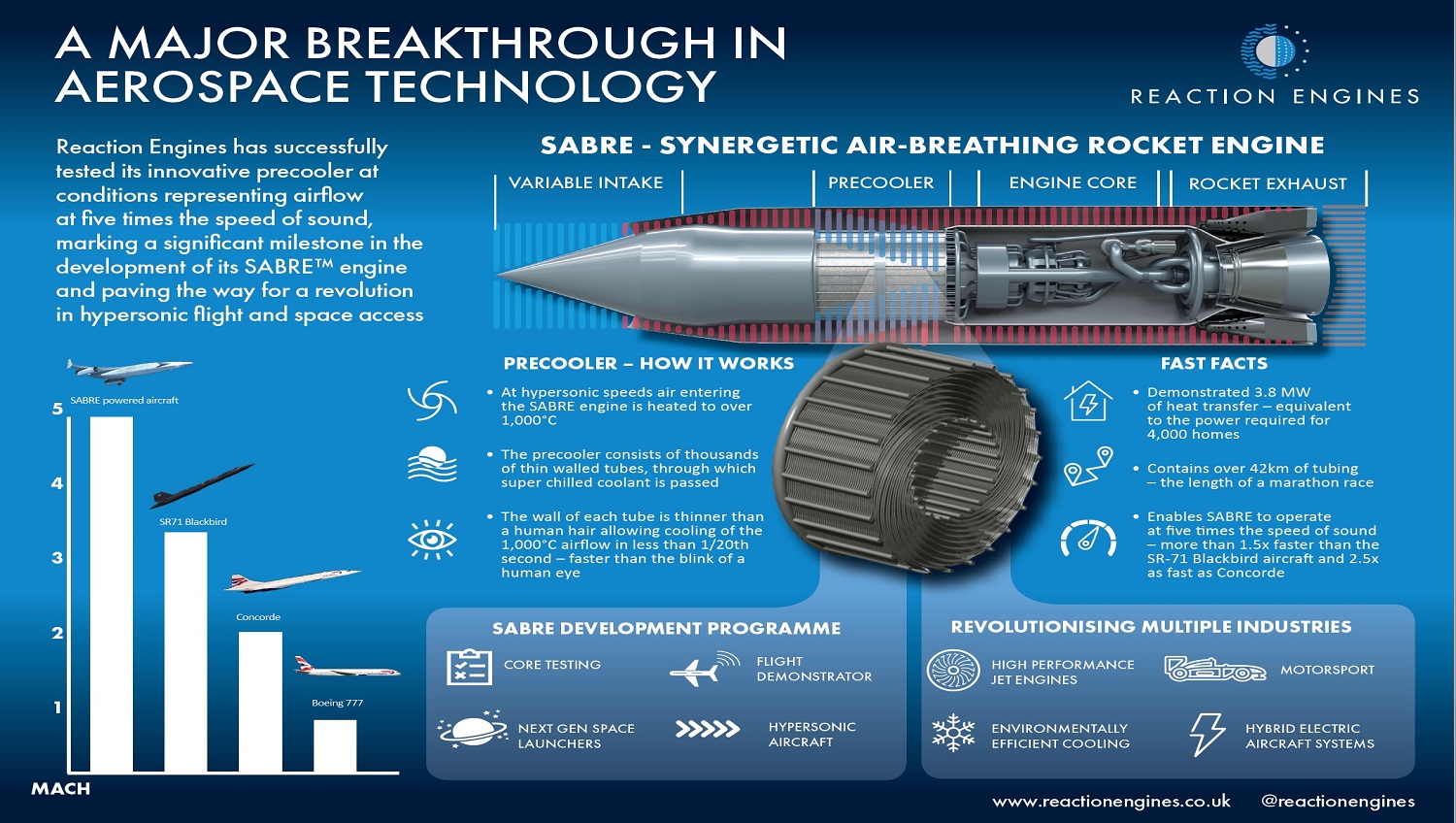The precooler heat exchanger is a vital component of the revolutionary SABRE air-breathing rocket engine, on which Reaction Engines is working in collaboration with companies including BAE Systems, and is an enabling technology for other precooled propulsion systems and a range of commercial applications.
This ground-based test achieved the highest temperature objective of the Company’s HTX testing programme and took place at its specially constructed unique facility at the Colorado Air and Space Port, United States.
During the latest series of tests, Reaction Engines’ unique precooler successfully quenched airflow temperatures in excess of 1,000°C (~1,800°F) in less than 1/20th of a second. The tests demonstrated the precooler’s ability to successfully cool airflow at speeds significantly in excess of the operational limit of any jet-engine powered aircraft in history. Mach 5 is more than twice as fast as the cruising speed of Concorde and over 50% faster than the SR-71 Blackbird aircraft – the world’s fastest jet-engine powered aircraft.
This most recent test builds upon the success of previous HTX hot tests undertaken in April which saw the precooler successfully operate at temperatures of 420ᵒC (~788ᵒF) – matching the thermal conditions corresponding to Mach 3.3 flight.
Mark Thomas, Chief Executive, Reaction Engines, said: “This is a major moment in the development of a breakthrough aerospace technology which has seen Reaction Engines’ precooler tested at Mach 5 airflow temperature conditions, smashing through previous achievements at Mach 3.3 temperatures and paving the way for hypersonic flight. In addition to its use in our SABRE class of air breathing rocket engines, there are numerous exciting commercial applications for our precooler technology, which delivers world-leading heat transfer capabilities at low weight and compact size, and we are seeing significant interest from a range of potential customers and technology partners.”
Investment
Over the last four years Reaction Engines has raised over £100m from public and private sources and has secured investment from companies including BAE Systems.
In 2015, it was announced that BAE Systems had made a strategic investment in Reaction Engines and committed to a working collaboration to accelerate the development of the SABRE engine.
This partnership was designed to draw on BAE Systems’ extensive aerospace technology development and project management expertise to provide Reaction Engines with access to critical industrial, technical and capital resources to progress towards the demonstration of a ground based engine – a key milestone in the development of the technology.
Phil Varty, Industrial Strategy Manager for BAE Systems Air, said: “Working together with Reaction Engines, we’re pushing technological boundaries to develop the SABRE air breathing rocket engine, an engine which could revolutionise hypersonic flight and space access. The precooler heat exchanger is an enabling technology that we also have a real interest in for a number of other defence and commercial applications, including future combat aircraft and maritime vessels. These latest trials demonstrate what can be achieved when we bring together the boldest and brightest minds from across the UK industry together. Our engineers have brought expertise in simulation, modelling and test & evaluation to the programme and we continue to work closely with Reaction Engines through the placement of graduates across both companies, exploiting the very best in small company thinking and large company experience.”

Reaction Engines’ patented precooler heat exchanger has the potential to be used in a wide range of commercial thermal management applications. These include the development of precooled systems that would significantly enhance the performance of existing jet engine technology, along with applications in automotive, aerospace, energy and industrial processes.
The HTX hot heat exchanger testing programme is a significant milestone on the roadmap to enabling transformational SABRE powered space access systems and has been keenly supported by the UK Space Agency (UKSA) and European Space Agency (ESA). In March, the two agencies reviewed and validated the preliminary design of the demonstrator engine core of SABRE, which Reaction Engines will use to undertake ground-based testing at its under-construction TF1 test facility at Westcott, Buckinghamshire, UK.
The HTX hot heat exchanger test programme was supported under a contract to the Company’s US subsidiary Reaction Engines Inc. by the Defense Advanced Research Projects Agency (DARPA). The precooler test item was designed and constructed at Reaction Engines’ headquarters in the UK, before being shipped to the Company’s Colorado site for testing.
Following this significant testing milestone, the Company will embark on achieving the next steps of the SABRE programme while also pursuing nearer-term opportunities that will benefit from the addition of the Company’s heat exchanger technology.



